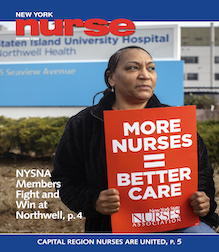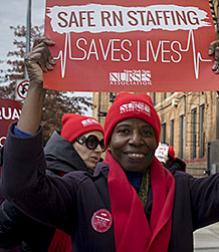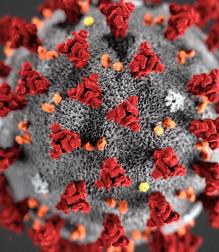
On July 31, public-sector nurses in New York City won a contract with historic pay increases that put them on par with private hospital nurse salaries. This was a massive victory for NYC Health+Hospitals (H+H)/Mayorals members, who are mostly people of color serving an underserved patient population — largely uninsured and underinsured Black and brown patients.
The crisis of low pay and understaffing
NYC H+H/Mayorals members took the issue of pay parity head-on in their contract fight. They identified the large and growing pay disparity between public- and private-sector nurses as the main reason for the high turnover and low staffing levels in public facilities. After making steady progress on safe staffing in their last contract three years ago, including winning ratios for the first time, they set their sights on pay parity to recruit and retain enough nurses to achieve those safe staffing levels in practice.
NYSNA Director at Large and President of NYSNA’s NYC H+H/Mayorals Executive Council Sonia Lawrence, RN, BSN, said: “We were hemorrhaging nurses, and we needed to level the playing field. So many public-sector nurses are dedicated to H+H’s mission of caring for all New Yorkers, but we can’t take care of our patients if we can’t take care of ourselves. What used to be a salary difference with the private sector of about $14,000 a year grew to nearly $20,000. That was too much incentive to leave the public sector.”
Low pay was harming retention and quality patient care. Through information requests and public testimony, nurses highlighted that H+H lost 2,000 nurses since the beginning of the pandemic, had sky-high turnover rates and was filling 25% of nursing positions with costly temporary travel nurses. They testified about the negative impact all that had on patient care — fewer nurses and less-experienced nurses were pushed to care for too many patients in all 11 public hospitals, in ambulatory care, long-term care, home care, jails and city agencies.
Roots of the Struggle
Pay equity, or pay parity with the private sector, is a matter of worker justice and racial justice. Many public-sector members were working multiple jobs to maintain a decent quality of life in New York City. The mostly Black, brown and immigrant nurses had had enough. They also saw the injustice that their patients, who looked like them, experienced due to understaffing.
It was no accident that H+H nurses had originally won a pay parity clause in their contract in 1968, during an intense period of civil rights and worker rights struggle. Mayor Rudy Giuliani suspended that pay parity clause in the 1990s during a period of disinvestment and attempted privatization of New York City’s public health system. As a result, the pay disparity between public- and private-sector nurses steadily grew to unjust and unsustainable levels.
As strong patient and social justice advocates, the nurses demanded health equity for their patients.
NYSNA NYC H+H/Mayorals Executive Council Secretary Kristle Simms-Murphy, RN, FNP, said: “We demanded fair funding for public and safety-net hospitals so that NYC’s public health system — the largest in the country, the closest to universal healthcare, and the only one dedicated to caring for all patients regardless of immigration status or ability to pay — could not only survive but thrive.”
Nurses called attention to the public system’s vital role in saving New York during the height of the COVID-19 pandemic and getting the city back on its feet. They highlighted the ongoing and critical role the public system plays in the pandemic, the mental health crisis and the asylum-seeker crisis.
From Martin Luther King Jr. Day to Black Women’s Equal Pay Day
The nurses ran an intense contract campaign, launching on Martin Luther King Jr. Day with a march on H+H’s downtown headquarters. During their speak-out and march on MLK Day, nurses held “I Am a Nurse” signs, a reference to “I Am a Man” signs that Memphis, Tennessee, sanitation workers held during their struggle for fair pay and safe working conditions in 1968.
In February, H+H/Mayorals members co-hosted a health equity forum with Public Advocate Jumaane Williams that brought together nurses, doctors, community advocates and faith leaders to discuss how to strengthen the city’s public health system to achieve health equity.
On March 2, the day their contract expired, nurses at nine public hospitals held rallies and candlelight vigils alongside elected officials and community leaders. Later that month, they testified at a City Council budget hearing, pressing the city to release full data on nurse vacancies, turnover and use of expensive temporary travel nurses. They also held a press conference with legislators at the state capitol in Albany to call for fair hospital funding.
In April, members testified at H+H annual meetings, and on May 10, hundreds rallied in Foley Square with the Rev. Al Sharpton to demand equity. They called on Mayor Eric Adams to do the right thing, and they highlighted the outrageous amount of money H+H was spending on temporary travel nurses. Based on limited data that H+H provided, NYSNA research made its first estimate of how much H+H spent in 2022 on temporary nurses — over one-half billion dollars — and nurses headed back to City Hall to testify.
Show Us the Money
The focus on this temp agency data proved valuable. New York City Comptroller Brad Lander demanded a full accounting of the costs of temps and the details of the contract H+H signed with Rightsourcing, a for-profit, private-equity firm supplying temporary nurses. With this information, NYSNA was able to show that the public system that cried poverty and constantly told nurses they should be satisfied to do more with less had actually spent billions on temporary staff.
Temporary nurses were earning nearly 3.5 times what staff nurses were earning, including all fringe benefits. We had evidence that it was costing the city too much to keep nurse pay so low. We were able to build more pressure on the mayor and the city by showing that doing the right thing and settling a fair contract was a matter of racial and economic justice, and it was also a matter of fiscal responsibility at a time when the city budget was under a microscope.
Nurses Escalate the Fight
With the budget deadline approaching at the end of June, NYC H+H/Mayorals nurses escalated their campaign for a fair contract. They braved an air-quality alert to rally and sit in at H+H/Bellevue on June 7. The next week, they were back at Jacobi making their voices heard with more direct actions. Then H+H/Lincoln, Kings, Elmhurst, Queens, and Harlem nurses picked up the torch and spoke out at their facilities, at times facing down intimidation by H+H administrators and hospital police.
H+H/Mayorals nurses refused to stay silent. Three members wrote opinion editorials in New York City’s daily newspapers, and they earned consistent media coverage of their actions, helping to build public and political support for their campaign. Elected officials posted encouraging messages on social media and even participated in a “wear red” day of action in solidarity with the nurses.
Down to the Wire
The pressure paid off. The city agreed to enter expedited mediation to settle the contract. In July, the Executive Council members started a grueling bargaining schedule, with the Bargaining Committee having their backs every step of the way.
The last day of bargaining was July 28, Black Women’s Equal Pay Day, so named because it takes Black women seven extra months into 2023 to earn the same pay that white men earned in 2022. Soon after, on the eve of the deadline we had given the city to settle the contract, the arbitrator came back with a binding award that the city was forced to follow. In short, the arbitrator agreed that NYSNA nurses were entitled to pay parity and safe staffing!
A Historic Contract
The total contract package, which 99% of members voted to endorse, includes a binding arbitration award for pay parity and safe staffing, several agreements to improve nurse retention and work life, and the creation of a citywide nurse float pool to improve staffing and reduce the overreliance on expensive temporary travel nurse contracts.
H+H/Mayorals members won the largest pay increase in public-sector nurse history. They broke through to win a 37% pay raise over 5.5 years, including a more than $21,000 pay equity bump in the first two years of the contract to make them competitive with private-sector nurse salaries.
Alizia McMyers, RN, MSP, and vice president of NYSNA’s H+H/Mayorals Executive Council, said: “We refused to back down, even when we heard from naysayers that we were asking for the impossible. All things are possible when we have a collective belief. I am so proud of what we accomplished for our patients and our profession.”
Throughout, nurses kept the focus of their contract fight on racial justice and health equity. By keeping their eyes on the prize, they ended up righting a historic wrong.




